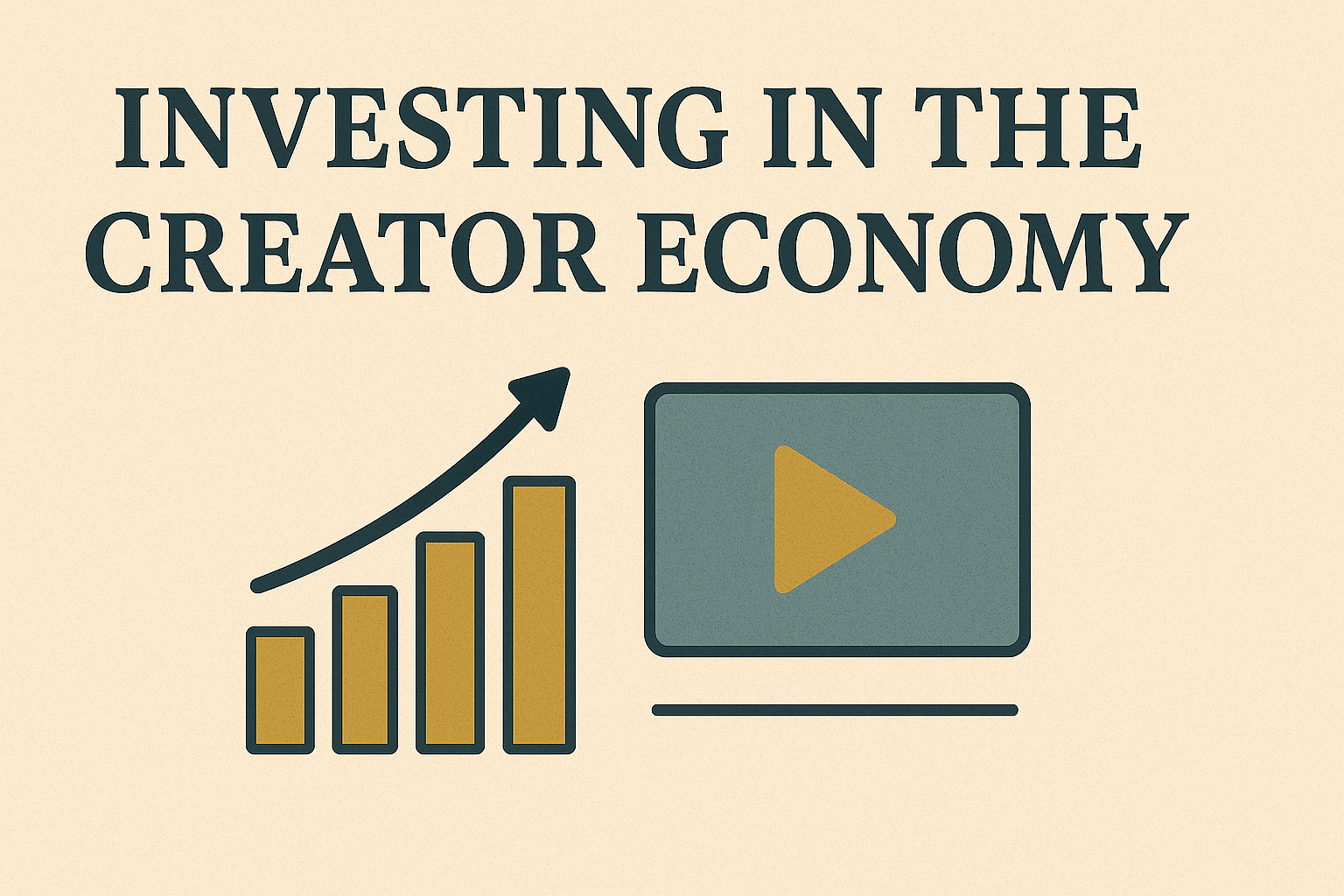Your cart is currently empty!
Investing in the Creator Economy

Investing in the creator economy has emerged as a compelling strategy for growth-oriented investors seeking diversification beyond traditional asset classes. Over the past decade, digital platforms and social media channels have empowered independent creators—ranging from video producers and podcasters to writers and designers—to monetize their audiences directly. Consequently, venture capitalists, institutional investors, and individual portfolio managers have turned their attention to the financial opportunities built around these digital creators. This article explores the key avenues for investing in the creator economy, examines the potential risks, and offers guidance on integrating creator-focused assets into a balanced portfolio.
Understanding the Creator Economy Landscape
The creator economy refers to the ecosystem that enables independent content producers to earn revenue through audience engagement and digital distribution. Platforms such as Patreon, YouTube, Substack, and TikTok provide infrastructure for subscription services, advertising revenue, tip jars, and merchandise sales. Beyond platform operators, specialized tools—like membership plugins, crowdfunding services, and analytics dashboards—play a pivotal role in facilitating creator earnings. As a result, an entire financial ecosystem has taken shape, presenting multiple levels at which investors can participate.
Founders of creator platforms have attracted billions in funding, fueling rapid innovation and expansion. For instance, Patreon’s business model underscores the shift away from ad-dependent revenue toward subscription-based models. Similarly, the integration of shopping features on platforms like Instagram and TikTok exemplifies the fusion of commerce and content. Understanding this landscape is vital for any investor considering investments in platform equities, private funding rounds, or derivative ventures that support digital creators.
Financial Growth and Market Potential
Market research estimates that the global creator economy surpassed $250 billion in gross merchandise value in 2024 and is projected to grow at a compound annual growth rate (CAGR) of over 12% through the end of this decade. This rapid expansion is driven by evolving consumer behavior, where audiences increasingly value direct relationships with creators over traditional media production houses. Furthermore, the surge in remote work and digital entrepreneurship has expanded the pool of potential creators, amplifying the size of the addressable market.
Moreover, macroeconomic factors—such as high interest rates and inflation concerns—have prompted investors to seek alternative growth engines outside conventional sectors. For those concerned about stock market volatility, resources like our guide on Navigating Market Volatility in a High Interest Rate Environment provide strategic context, while insights into resilient personal finance measures can be found in Recession-Proofing Your Personal Finances: 5 Essential Strategies. These complementary perspectives help frame the creator economy within a broader financial plan.
Equity Opportunities in Creator-Focused Platforms
Publicly traded platforms that serve creators represent a straightforward entry point for equity investors. Companies such as Alphabet (parent of YouTube), Meta Platforms (owner of Instagram and Facebook), and Snap Inc. (operator of Snapchat) derive significant revenue from creator-generated content. The performance of these large-cap stocks often correlates with platform engagement metrics, advertising spend, and new feature rollouts designed to boost creator monetization.
For investors seeking deeper analysis of platform-specific prospects, our in-depth examination of Palantir’s Growth Performance offers a model for evaluating the fundamentals of technology-led firms. While Palantir is not a creator platform per se, the approach to assessing recurring revenue streams, customer concentration, and R&D investment applies equally to social media companies. By analyzing user acquisition costs, engagement rates, and monetization pathways, investors can gauge which public platforms might deliver outsized returns as the creator economy matures.
Venture Capital and Startup Investments
Beyond publicly traded equity, venture capital (VC) and private equity funds have become major financiers of early-stage creator economy startups. Investors with access to private deals can support platforms that enable subscription-based communities, micro-transactions, and digital product marketplaces. Examples include platforms for live events streaming, niche podcast networks, and educational course providers tailored to creator audiences.
Institutional investors often allocate a portion of their venture portfolio to “creator enablement” companies, betting on the next generation of tools that streamline content production, analytics, or commerce integration. For individual investors without direct VC access, specialized funds and secondary marketplaces offer curated exposure to these private assets. Resources like Private Credit: A Beginner’s Guide can help investors understand alternative financing structures, while our coverage of Key Economic Indicators to Watch provides macro context for fundraising environments.
Alternative Paths: Creator-Driven Revenue Models
In addition to platform and VC investments, direct partnerships and sponsorship arrangements represent an unconventional avenue for capitalizing on the creator economy. Brands have increasingly allocated marketing budgets to sponsor content, pay for product reviews, or collaborate on co-branded merchandise. Forward-thinking investors may consider participating in revenue-sharing agreements or convertible note structures that fund a creator’s expansion in exchange for a percentage of future earnings.
Furthermore, investors can explore decentralized finance (DeFi) and tokenization models that allow fans to purchase creator tokens, effectively decentralizing ownership in a creator’s brand. These experimental models carry higher risk but can deliver significant upside if token value appreciates with audience growth. Interested readers may reference our Ultimate Guide to Saving for a Home in a Housing Market to understand strategic allocation principles that apply to unconventional investments as well.
Risk Management and Due Diligence
While the creator economy offers attractive growth prospects, investors must remain vigilant about potential pitfalls. Platform regulatory risks—such as changes in content moderation policies or antitrust scrutiny—can swiftly alter revenue trajectories. Moreover, the shift toward subscription models may provoke consumer fatigue if content quality fails to meet evolving expectations. Investors should conduct thorough due diligence, examining metrics like creator churn rates, average revenue per user, and platform diversification strategies.
In addition, macroeconomic conditions and interest rate cycles influence discretionary spending on digital content. When budgeting for new investments, individuals can reference fundamental personal finance strategies outlined in Credit Repair and Financial Coaching: How to Improve Your Score. Understanding one’s own financial resilience is critical before allocating capital to higher-volatility creator economy assets.
Integrating Creator Economy Investments into Your Portfolio
A well-balanced portfolio typically blends traditional assets—such as equities, bonds, and real estate—with alternative investments to enhance diversification and potential returns. Allocating a modest percentage (e.g., 5–10%) to creator economy exposures can provide asymmetric upside while limiting downside risk. Investors may choose a tiered approach: a core holding in large-cap tech platforms, supplemented by targeted stakes in private funding rounds and experimental creator token models.
Rebalancing is essential to maintain desired risk profiles. As creator economy assets appreciate, periodic adjustments ensure that gains do not disproportionately skew overall portfolio allocation. Additionally, investors should monitor correlation patterns between platform equities and broader market indices, adapting strategies when volatility spikes in risk assets.
Regulatory and Tax Considerations
Investing in the creator economy raises unique regulatory and tax implications. Equity positions in public companies follow conventional capital gains treatment, but private investments and tokenized assets may trigger distinct tax events. For example, revenue-sharing agreements might be classified as ordinary income, while token appreciation could involve complex crypto-asset reporting requirements.
Investors should seek guidance from tax professionals experienced in digital assets and private equity. Staying abreast of evolving regulations—particularly those governing digital payments, content licensing, and data privacy—helps mitigate compliance risks. Moreover, understanding the impact of cross-border investments is crucial when targeting creators and platforms that operate globally.
Future Outlook for Investing in the Creator Economy
Looking ahead, the creator economy is poised to evolve alongside emerging technologies such as augmented reality, non-fungible tokens (NFTs), and artificial intelligence-driven content creation. These innovations could unlock new monetization channels and audience engagement formats, further expanding the investment landscape. Furthermore, consolidation among platforms may reshape competitive dynamics, creating opportunities for strategic acquisitions that benefit equity holders.
Continued professionalization of creator businesses—through partnerships, talent agencies, and brand collaborations—will likely drive revenue stability. As seasoned investors embrace this asset class, the influx of capital may accelerate platform innovation, ultimately benefiting creators and audiences alike. With disciplined analysis and prudent risk management, investing in the creator economy offers a pathway to capture the next wave of digital transformation.
Conclusion
Investing in the creator economy requires a multifaceted approach that spans public equities, private funding rounds, direct revenue partnerships, and emerging tokenized models. By combining thorough due diligence with strategic portfolio integration and an eye toward regulatory considerations, investors can position themselves to benefit from the rapid growth of content-driven entrepreneurship. As the creator ecosystem matures, those who understand the underlying value drivers and maintain active risk management will be best equipped to harness the financial opportunities ahead.

Mr. Rajeev Prakash
Rajeev is a well-known astrologer based in central India who has a deep understanding of both personal and mundane astrology. His team has been closely monitoring the movements of various global financial markets, including equities, precious metals, currency pairs, yields, and treasury bonds.
Featured Post
Financial Astrology Terminal
The Financial Astrology Terminal is a web platform that combines real-time U.S. market data (S&P 500, Nasdaq, Dow, Russell, key stocks and commodities like gold and silver) with planetary cycles, giving traders and investors astro-timing signals on top of normal charts and analysis.
